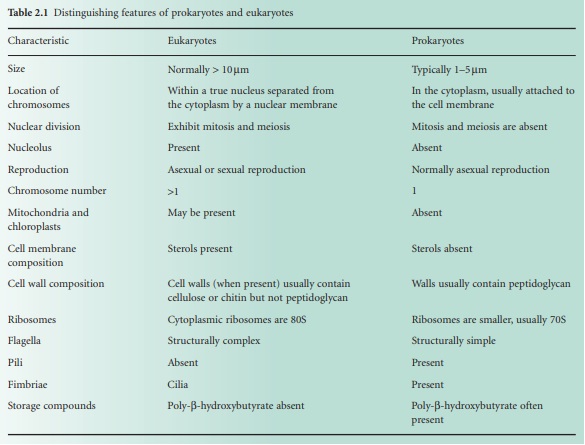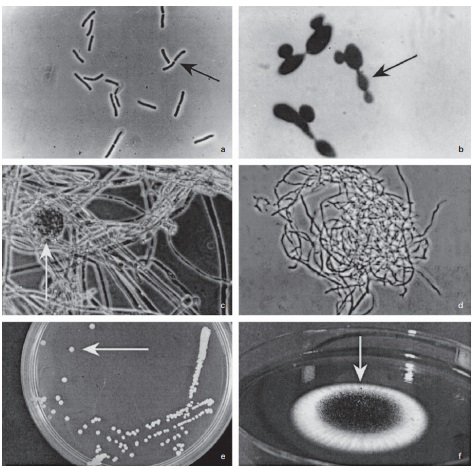Fundamental features of microbiology
| Home | | Pharmaceutical Microbiology | | Pharmaceutical Microbiology |Chapter: Pharmaceutical Microbiology : Fundamental features of microbiology
Microorganisms differ enormously in terms of their shape, size and appearance and in their genetic and metabolic characteristics. All these properties are used in classifying microorganisms into the major groups with which many people are familiar, e.g. bacteria, fungi, protozoa and viruses, and into the less well known categories such as chlamydia, rickettsia and mycoplasmas.
FUNDAMENTAL FEATURES OF MICROBIOLOGY
Introduction
Microorganisms
differ enormously in terms of their shape, size and appearance and in their
genetic and metabolic characteristics. All these properties are used in classifying
microorganisms into the major groups with which many people are familiar, e.g.
bacteria, fungi, protozoa and viruses, and into the less well known categories
such as chlamydia, rickettsia and mycoplasmas. The major groups are the subject
of individual chapters immediately following this, so the purpose here is not
to describe any of them in great detail but to summarize their features so that
the reader may better understand the distinctions between them. A further aim
of this chapter is to avoid undue repetition of information in the early part
of the book by considering such aspects of microbiology as cultivation,
enumeration and genetics that are common to some, or all, of the various types
of microorganism.
Viruses, viroids and prions
Viruses
do not have a cellular structure. They are particles composed of nucleic acid
surrounded by protein; some possess a lipid envelope and associated
glycoproteins, but recognizable chromosomes, cytoplasm and cell membranes are
invariably absent. Viruses are incapable of independent replication as they do
not contain the enzymes necessary to copy their own nucleic acids; as a
consequence, all viruses are intracellular parasites and are reproduced using
the metabolic capabilities of the host cell. A great deal of variation is
observed in shape (helical, linear or spherical), size (20–400 nm) and nucleic
acid composition (single or double-stranded, linear or circular RNA or DNA), but
almost all viruses are smaller than bacteria and they cannot be seen with a
normal light microscope; instead they may be viewed using an electron
microscope which affords much greater magnification.
Viroids
(virusoids) are even simpler than viruses, being infectious particles
comprising single-stranded RNA without any associated protein. Those that have
been described are plant pathogens, and, so far, there are no known human
pathogens in this category, although human hepatitis D virus shares some features
in common with viroids, and may have originated from them.
Prions
are unique as infectious agents in that they contain no nucleic acid. A prion
is an atypical form of a mammalian protein that can interact with a normal
protein molecule and cause it to undergo a conformational change so that it, in
turn, becomes a prion and ceases its normal function. Prions are the agents
responsible for transmissible spongiform encephalopathies, e.g. Creutzfeldt–Jakob
disease (CJD) and bovine spongiform encephalopathy (BSE). They are the simplest
and most recently recognized agents of infectious disease, and are important in
a pharmaceutical context owing to their extreme resistance to conventional
sterilizing agents like steam, gamma radiation and disinfectants.
Prokaryotes and eukaryotes
The
most fundamental distinction between the various microorganisms having a
cellular structure, is their classification into two groups—the prokaryotes and
eukaryotes— based primarily on their structural characteristics and mode of
reproduction. Expressed in the simplest possible terms, prokaryotes are the
bacteria and archaea, and eukaryotes are all other cellular microorganisms,
e.g. fungi, protozoa and algae. The crucial difference between these two types
of cell is the possession by the eukaryotes of a true cell nucleus in which the
chromosomes are separated from the cytoplasm by a nuclear membrane. The
prokaryotes have no true nucleus; they normally possess just a single
chromosome that is not separated from the other cell contents by a membrane.
Other major distinguishing features of the two groups are that prokaryotes are
normally haploid (possess only one copy of the set of genes in the cell) and
reproduce asexually; eukaroyotes, by contrast, are usually diploid (possess two
copies of their genes) and normally have the potential to reproduce sexually. The
capacity for sexual reproduction confers the major advantage of creating new
combinations of genes, which increases the scope for selection and evolutionary
development. The restriction to an asexual mode of reproduction means that the
organism in question is heavily reliant on mutation as a means of creating
genetic variety and new strains with advantageous characteristics, although
many bacteria are able to receive new genes from other strains or species.
Table 2.1 lists some distinguishing features of the prokaryotes and eukaryotes.

Bacteria and archaea
Bacteria are essentially unicellular, although some species arise as sheathed chains of cells. They possess the properties listed under prokaryotes in Table 2.1 but, like viruses and other categories of microorganisms, exhibit great diversity of form, habitat, metabolism, pathogenicity and other characteristics. The bacteria of interest in pharmacy and medicine belong to the group known as the eubacteria. The other subdivision of prokaryotes, the archaea, have no pharmaceutical importance, and although formerly considered largely to comprise organisms capable of living in extreme environments (e.g. high temperatures, extreme salinity or pH) or organisms exhibiting specialized modes of metabolism (e.g. by deriving energy from sulphur or iron oxidation or the production of methane) they are now known to occur in a wide variety of habitats
The
eubacteria are typically rod shaped (bacillus), spherical (cocci), curved or
spiral cells of approximately 0.5–5.0 mm (longest dimension) and are divided
into two groups designated Gram-positive and Gram-negative according to their
reaction to a staining procedure developed in 1884 by Christian Gram. Although
all the pathogenic species are included within this category, there are very
many other eubacteria that are harmless or positively beneficial. Some of the
bacteria that contaminate or cause spoilage of pharmaceutical materials are
saprophytes, i.e. they obtain their energy by decomposition of animal and vegetable
material, while many could also be described as parasites (benefiting from
growth on or in other living organisms without causing detrimental effects) or
pathogens (parasites damaging the host). Rickettsia and chlamydia are types of
bacteria that are obligate intracellular parasites, i.e. they are incapable of
growing outside a host cell and so cannot easily be cultivated in the
laboratory. Most bacteria of pharmaceutical and medical importance possess cell
walls (and are therefore relatively resistant to osmotic stress), grow well at
temperatures between ambient and human body temperature, and exhibit wide
variations in their requirement for, or tolerance of, oxygen. Strict aerobes
require atmospheric oxygen, but for strict anaerobes oxygen is toxic. Many
other bacteria would be described as facultative anaerobes (normally growing
best in air but can grow without it) or micro-aerophils (preferring oxygen concentrations
lower than those in normal air).
Fungi
Fungi are structurally more complex and varied in appearance than bacteria and, being eukaryotes, differ from them in the ways described in Table 2.1. Fungi are considered to be non-photosynthesizing plants, and the term fungus covers both yeasts and moulds, although the distinction between these two groups is not always clear. Yeasts are normally unicellular organisms that are larger than bacteria (typically 5–10 µm) and divide either by a process of binary fission (Figure 2.1a) or budding (whereby a daughter cell arises as a swelling or protrusion from the parent that eventually separates to lead an independent existence, Figure 2.1b). Mould is an imprecise term used to describe fungi that do not form fruiting bodies visible to the naked eye, thus excluding toadstools and mushrooms. Most moulds consist of a tangled mass (mycelium) of filaments or threads (hyphae) which vary between 1 and over 50 µm wide (Figure 2.1c); they may be differentiated for specialized functions, e.g. absorption of nutrients or reproduction. Some fungi may exhibit a unicellular (yeastlike) or mycelial (mouldlike) appearance depending upon cultivation conditions. Although fungi are eukaryotes that should, in theory, be capable of sexual reproduction, there are some species in which this has never been observed. Most fungi are saprophytes with relatively few having pathogenic potential, but their ability to form spores that are resistant to drying makes them important as contaminants of pharmaceutical raw materials, particularly materials of vegetable origin.

Figure 2.1 (a) A growing culture of Bacillus megaterium in which cells about to divide by binary fission display constrictions (arrowed) prior to separation. (b) A growing culture of the yeast Saccharomyces cerevisiae displaying budding (arrowed). (c) The mould Mucor plumbeus exhibiting the typical appearance of a mycelium in which masses of asexual zygospores (arrowed) are formed on specialized hyphae. (d) The bacterium Streptomyces rimosus displaying the branched network of filaments that superficially resembles a mould mycelium. (e) The typical appearance of an overnight agar culture of Micrococcus luteus inoculated to produce isolated colonies (arrowed). (f) A single colony of the mould Aspergillus niger in which the actively growing periphery of the colony (arrowed) contrasts with the mature central region where pigmented asexual spores have developed.
Protozoa
Protozoa
are eukaryotic, predominantly unicellular microorganisms that are regarded as animals
rather than plants, although the distinction between protozoa and fungi is not
always clear and there are some organisms whose taxonomic status is uncertain.
Many protozoa are free living motile organisms that occur in water and soil,
although some are parasites of plants and animals, including humans, e.g. the
organisms responsible for malaria and amoebic dysentery. Protozoa are not normally
found as contaminants of raw materials or manufactured medicines and the
relatively few that are of pharmaceutical interest owe that status primarily to
their potential to cause disease.
